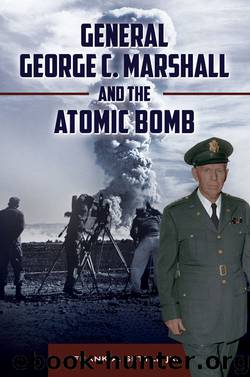General George C. Marshall and the Atomic Bomb by Frank Settle

Author:Frank Settle
Language: eng
Format: mobi, epub
ISBN: 9781440842856
Publisher: ABC-CLIO
Published: 2016-04-29T21:00:00+00:00
CHAPTER NINE
Japan’s Response to the Potsdam Declaration, Hiroshima, and Nagasaki
At the end of July 1945 the leaders of the governments of the United States and Japan remained deadlocked on the means of ending the war. Two immediate military options for the United States were a costly invasion or the continuation of the bombing and blockade. Japan’s choices were to seek terms of surrender that left the emperor on the throne with additional Allied concessions or to offer fierce resistance in hopes that the American public would weary of the war and accept surrender terms favorable to Japan. The atomic bomb and the Soviet Union’s entry into the war changed the options for both the United States and Japan (see Appendix D).
As a result of the successful Trinity test, U.S. leaders activated plans for dropping atomic bombs as they became available on the selected Japanese cities. Groves informed Marshall about preparations for the bombing missions. MAGIC intercepts of Japanese diplomatic and military communications indicated that the Japanese leaders remained divided on the means of ending the war. On July 25, the day before the issuance of the Potsdam Declaration, Marshall approved the missions for the atomic bombing of Japan (see Appendix C). The Japanese response would determine whether or not the missions went forward.
In late July and early August Marshall endured two periods of heightened anxiety. The first began with the Potsdam Declaration on July 26 and ended with Prime Minister Suzuki’s July 29 reply. The second was the interval from the atomic bombing of Hiroshima on August 6 until the Japanese acceptance of the Allies’ surrender terms on August 14. During the first period, Marshall hoped the Japanese would accept the surrender terms to quickly end the war. This would eliminate the planned invasion and use of the atomic bomb. After the atomic bombs were used, Marshall again anxiously awaited the second opportunity for Japan to surrender. He was not eager to order the invasion, which he felt would be necessary should Japan’s leaders choose to fight on.
Download
General George C. Marshall and the Atomic Bomb by Frank Settle.epub
This site does not store any files on its server. We only index and link to content provided by other sites. Please contact the content providers to delete copyright contents if any and email us, we'll remove relevant links or contents immediately.
| Afghan & Iraq Wars | American Civil War |
| American Revolution | Vietnam War |
| World War I | World War II |
Waking Up in Heaven: A True Story of Brokenness, Heaven, and Life Again by McVea Crystal & Tresniowski Alex(37031)
Empire of the Sikhs by Patwant Singh(22200)
We're Going to Need More Wine by Gabrielle Union(18100)
Hans Sturm: A Soldier's Odyssey on the Eastern Front by Gordon Williamson(16971)
Leonardo da Vinci by Walter Isaacson(11943)
The Radium Girls by Kate Moore(10938)
Educated by Tara Westover(7093)
Tools of Titans by Timothy Ferriss(6992)
How to Be a Bawse: A Guide to Conquering Life by Lilly Singh(6718)
The Last Black Unicorn by Tiffany Haddish(5091)
Permanent Record by Edward Snowden(5025)
The Rise and Fall of Senator Joe McCarthy by James Cross Giblin(4856)
Promise Me, Dad by Joe Biden(4467)
The Wind in My Hair by Masih Alinejad(4437)
The Crown by Robert Lacey(4125)
A Higher Loyalty: Truth, Lies, and Leadership by James Comey(4050)
The Iron Duke by The Iron Duke(3663)
Joan of Arc by Mary Gordon(3280)
How to be Champion: My Autobiography by Sarah Millican(3202)
